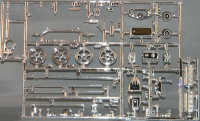
MPC 1/25 Hot Rod Ford Mustang Funny Car Kit First Look
By Phil Cooley, Front Range Auto Modelers (FRAM)
| Date of Review | October 2013 | Manufacturer | MPC/Round 2 |
|---|---|---|---|
| Subject | Hot Rod Ford Mustang Funny Car | Scale | 1/25 |
| Kit Number | 801 | Primary Media | Styrene |
| Pros | Authentic early 70s Funny Car body; tires are very nicely molded and printed | Cons | Instructions don't have the parts names on them (that is how I learned what the names of various car parts was when I was growing up) |
| Skill Level | Intermediate | MSRP (USD) | $24.95 |
First Look
 |
 |
 |
 |
 |
 |
 |
 |
In the late 60s and early 70s some of the most exciting cars you could see at the dragstrip were the Nitro-Methane powered Funny Cars. Although they had different body styles, under their fiberglass exteriors there was a lot of commonality especially in the powerplant; most were powered by a supercharged elephant motor, i.e, the fabulous 426 Chrysler Hemi. Putting out hundreds if not thousands of horsepower, these engines pushed the Funny Cars into low 7 second quarter mile times at nearly 250 mph!
This MPC/Round 2, 1/25 scale model appears to be a fairly faithful rendition of one of those 1970s Funny Cars. In my research for this article, I didn't find a real "Hot Rod" Ford Mustang Funny Car, but I did find several similar ones, like the Stone, Woods and Cook's Dark Horse 2, Tocco and Garten's Warhorse, and the Danny Ongias' driven Parnelli Jones Ford Mustang Funny Car. I suspect that the "Hot Rod" motif was done because licensing rights could not be secured for the original version of this model, but I don't know that for sure. Interestingly, if you buy this kit, it comes with a card for a free one-year subscription to Hot Rod magazine.
The body represents a 1972 Mustang. I'm basing this on the roofline, grille, and hood. It is molded in white and appears to be pretty faithful to the real Funny Cars of the era. It does have some mold lines along the tops of the rear quarter panels, the tops of the front fenders, and the rear bumper, taillight and valence. And there are two huge ejection tabs along the driver's rocker panel—you'll need to carefully remove them and then will need to do some filling and sanding to get the rocker panel looking right. Obviously, the molding lines will require some sanding, too.
Moving on, let's examine the 22 piece engine. The block, heads, intake manifold, front cover, oil filler, fuel pump, headers, transmission and and drive belt are molded in black. The rest of the engine, which includes the oil pan, valve covers and blower assembly are chrome plated. The chrome appears to be well applied—i.e., it has a nice sheen but isn't so thick that it obscures detail.
The tube chassis is molded in one piece—although the tubing is dainty, it is well braced and the chassis is straight. The front and rear suspensions are chrome plated, as are the locating arms, tie rod and such. The rear wheels are mounted via a metal axle, the fronts are secured by heat swaging the front axle. The rear disc brakes and calipers add a nice detailing touch. The kit includes wheelie bars, as well.
Speaking of the wheels and tires, the slicks are very nicely done tampo-printed Goodyears. The skinnys up front have a nice tread pattern and contrary to many kits of today, have the manufacturer's name molded on the sidewall. The small script says "Derman Premium Sports, 4 Ply Nylon, Handcrafted".
The interior includes a molded cockpit, separate roll cage, instrument pod, steering column and competition steering "wheel". There is also a clear windshield and top and rear bulkheads complete with hinges so the body can be displayed open.
Interestingly, there are two closed parachute packs as well as two open parachutes (along with instructions on how to rig them).
Finally, the decals—the front grill and rear taillight and trim assembly are part of the decal sheet. In looking at the 1:1 Funny Cars of this era, this is just the way they were done—i.e, the grille was done as a separate graphic, then applied to the car. The decal sheet also includes lace panels, the Hot Rod logos and various sponsor decals. There are no specific graphics to help with decal placement, though the pictures on the box give you a pretty good idea where everything goes.
So, what is my assessment of this kit? I think this MPC/Round 2 re-release is very nicely done. If you want to build an authentic early 70s Mustang Funny Car, it's a great starting point. Straight out of the box, it should build up as a nice display model. And if you want to super-detail it, the basics are all there, waiting for you to make it even better.
My sincere thanks to Round2 Models for this review sample







